Menu
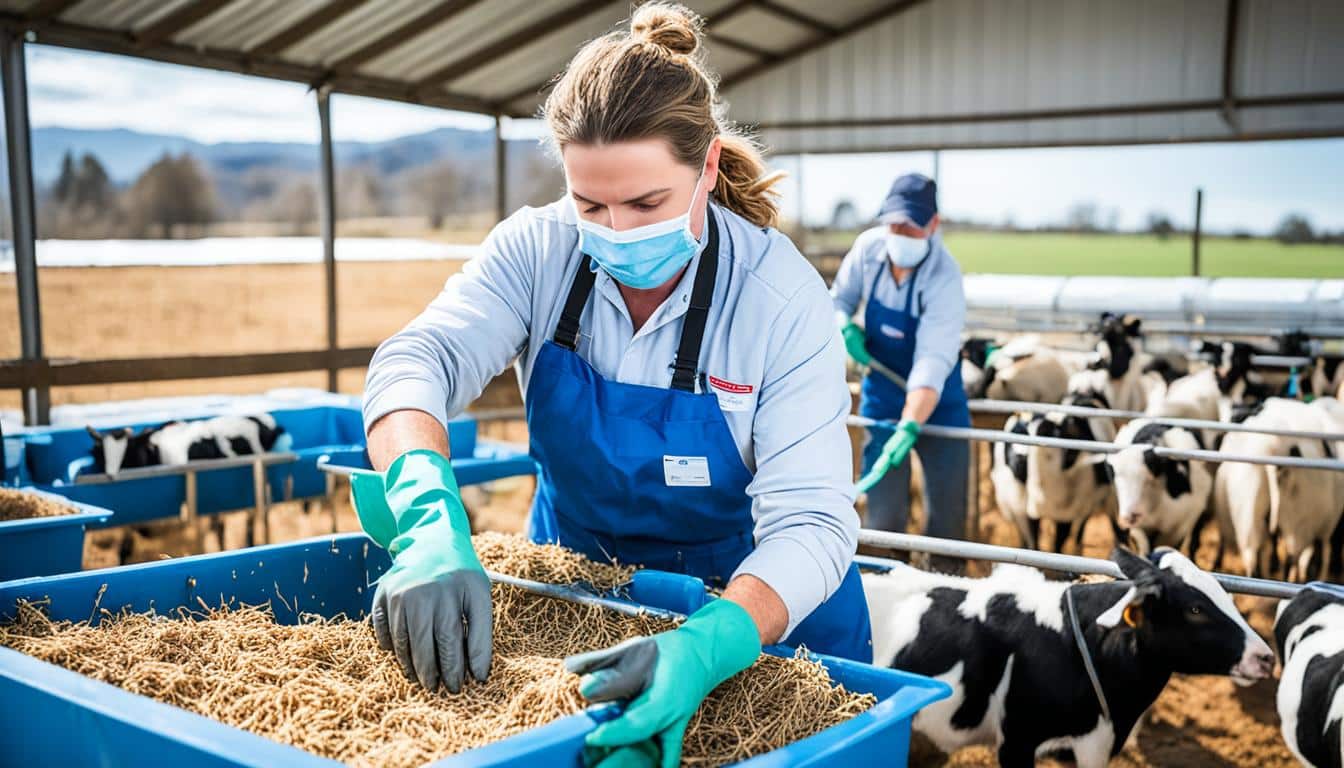
Have you ever wondered how much our actions help spread zoonotic diseases? Human activities in areas we live in have increased zoonotic host diversity by 20% (Gibb et al., 2020). This shows we have a big role in how diseases spread. On farms, it’s crucial to manage zoonotic diseases with proven steps.
Researchers like Loh et al. (2015) tell us that stopping the spread of diseases is key. They say to focus on how diseases move to prevent them better. The Intergovernmental Platform on Biodiversity and Ecosystem Services (IPBES) adds that knowing and controlling these disease paths is vital. Doing so helps lower the risks for both people and animals.
It’s essential to watch closely for diseases and put in strong controls on farms. By doing this, we can reduce the dangers these diseases pose. It’s a way of protecting human and animal health by paying attention to detail.
Zoonotic diseases, or zoonoses, can spread from animals to humans. There are over 200 known types, showing how wide and varied they are. They make up a big part of the new diseases we find, which is why they are a big worry for health officials.
These illnesses come from germs like bacteria, viruses, and fungi. Interestingly, nearly two-thirds of the germs that make us sick initially came from animals. Some well-known zoonotic diseases are:
Knowing where zoonotic diseases come from is vital to stop their spread. A few things help these diseases move from animals to people:
Preventing zoonotic diseases is complex and needs many solutions. Woolhouse and Gowtage-Sequeria (2005) say we need to look at the environment, biology, and the way societies work to truly stop these zoonoses.
It’s vital to know how to stop zoonotic diseases, as they can harm people and the economy. Diseases like Ebola and SARS cause most human communicable illnesses. They can come from many sources and badly affect public health.
Cutaneous anthrax is a key example, causing 95% of human anthrax cases. It most often affects the skin but can turn deadly with septicemia. This happens if the illness spreads to nearby lymph nodes. If inhaled, as with pulmonary anthrax, it’s almost always fatal.
Gastrointestinal anthrax comes from eating undercooked meat and is half deadly. Oropharyngeal anthrax infects the mouth, causing fever and swelling. These show how serious zoonotic diseases are for health.
Farmers face big financial hits from outbreaks, with losses and higher costs. Preventing these diseases is crucial for livestock safety and farming’s financial health. It protects both the animals and the money farmers make.
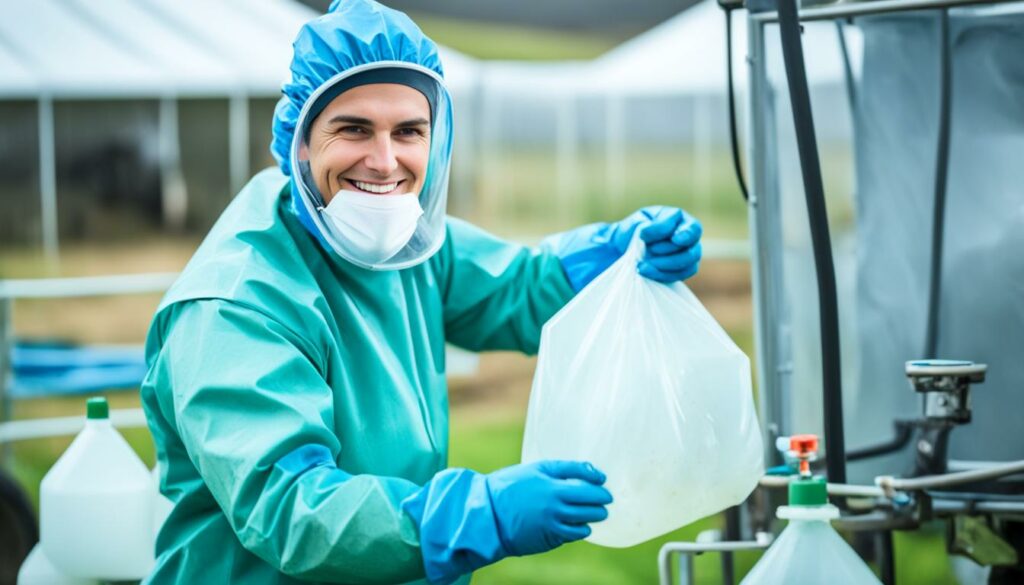
| Zoonotic Disease | Impact on Health | Economic Consequences |
|---|---|---|
| Cutaneous Anthrax | 95% of cases in humans; potential fatal progression in 10% of cases | Loss of livestock, market restrictions |
| Pulmonary Anthrax | Virtually 100% fatal once septicemia sets in | Severe economic strain due to livestock casualties |
| Gastrointestinal Anthrax | Symptoms include fever, vomiting; at least 50% fatal | Increased operational costs for farmers |
| Oropharyngeal Anthrax | Fever, mucosal lesions, significant edema | Loss of stock and potential quarantine measures |
Knowing how to prevent zoonotic diseases is crucial. It protects both people and the income of farmers. Good prevention methods make farming safer and more reliable.
Knowing how diseases spread on farms is key to stopping them. When animals and people closely interact, like in intensive farming, the risk of disease can be high. This is why it’s so important to look closely at how these diseases are shared and find ways to prevent them.
Getting sick from animals often happens through direct touch. Germs can move when we handle sick animals or their body parts. Many new diseases, about two-thirds, jump from animals to people, and three-quarters of those come from wild animals. For example, Snyder and colleagues found that a dangerous bacteria could move from pork to kitchen surfaces many times. This shows why we must be careful in how we handle food and butchered animals.
How we interact with the environment also affects how diseases spread from animals to people. Things like dirty equipment, clothes, or vehicles can move germs between animals and us. A report on Biodiversity and Pandemics (2020) says that destroying habitats for things like farming can make these disease paths worse. So, keeping animal areas clean and looking after the environment are big steps in preventing us from getting animal diseases.
Biosecurity on farms is vital for stopping the spread of zoonotic diseases. It stops diseases from entering or moving around farms. This includes keeping different animal types apart and wearing the right protective gear.
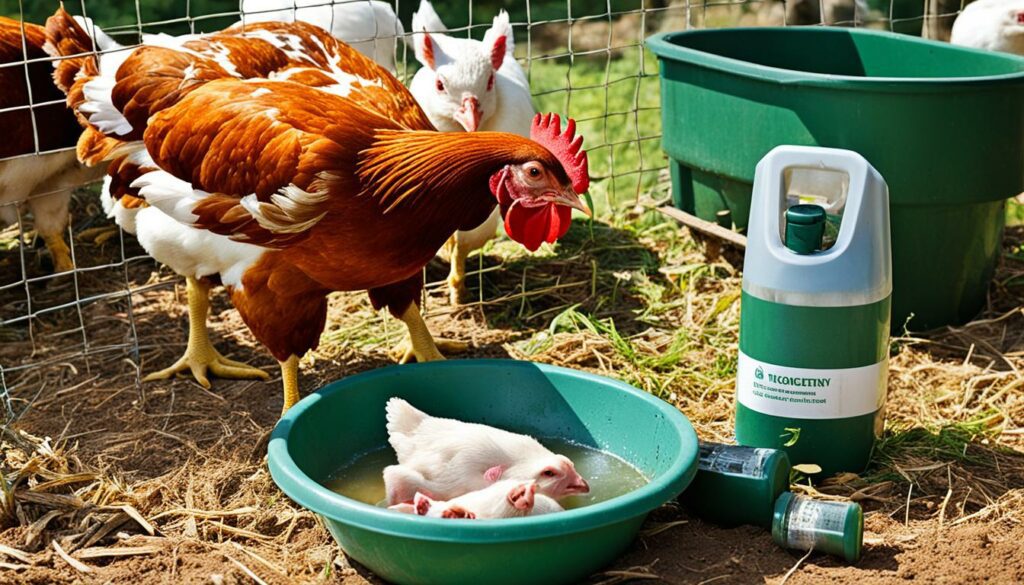
Separating animals is key to reducing how diseases jump between species. Doing this not only helps against zoonotic diseases but also limits the spread within one type of animal. It’s known that keeping animals away from each other is a strong way to prevent disease, from direct touch to the air. Regular checks and upkeep make this strategy even more effective.
Using the correct protective gear is a big part of farm biosecurity. It’s important that everyone follows the rules to keep risks low. Things like gloves, masks, and boots lower the chance of getting sick. When workers use personal protective equipment (PPE), the farm’s safety gets a big boost.
Looking after animals well is crucial for stopping zoonotic diseases. By using ethical and careful methods, we lower the danger of diseases spreading between animals and humans. Good spacing and food help animals stay healthy.
Recent studies show how important good care is. A meta-analysis looked at human diarrhoea caused by how we look after domestic animals. Animal care and disease prevention in farming has big health benefits.
There’s also a study on Campylobacter and kids getting sick in Peru. It shows how poor farming practices can harm health. So, taking care of animals well is vital.
Another study focuses on poultry and the pathogen Campylobacter jejuni. It proves the need for strict measures on poultry farms. This keeps both animals and people safe from diseases.
Reducing stress in animals is key, too. Stressed animals are more likely to get sick and spread diseases. Managing stress is critical for keeping everyone healthy.
By combining good food, enough space, and keeping stress low, we keep diseases at bay. These practices, when done ethically, protect both farm workers and the public.
| Study | Key Finding |
|---|---|
| Mapping of Poverty and Likely Zoonoses Hotspots | Identifies regions vulnerable to zoonotic diseases due to poverty |
| Human diarrhea infections associated with domestic animal husbandry | Links between animal husbandry and human health |
| Geophagia as a risk factor for diarrhea | Role of geophagia in diarrheal diseases |
| Poultry as a host for the zoonotic pathogen Campylobacter jejuni | Potential health risks associated with poultry farming |
| Understanding and managing zoonotic risk in the new livestock industries | Necessity to address evolving zoonotic risks in livestock sectors |
Good animal care is not just about a farm. It helps protect us from diseases. By doing the right things, we create a safer environment for everyone.
Watching animal health closely and noting zoonotic infections are key in farm health care. Keeping a close eye and careful records can spot zoonotic diseases early. This helps stop a disease before it gets out of hand, protecting animals and people.
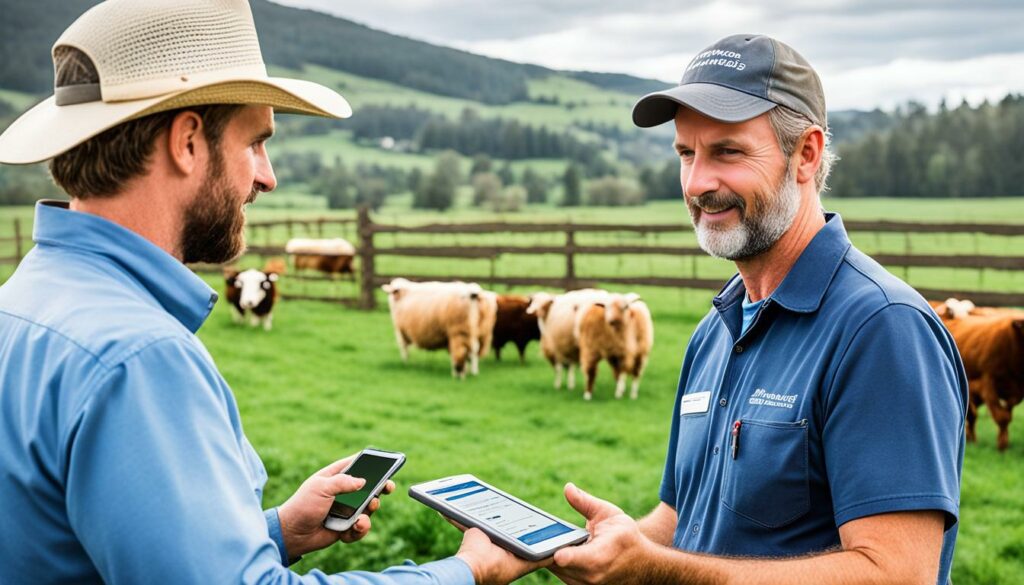
Regular health checks are essential for keeping animals healthy. They help find problems quickly, which means they can be treated early. Nearly 60 percent of diseases that infect humans come from animals, so this step is very important.
It is critical to keep detailed health records. These records not only help manage diseases but also offer insights during health checks. For example, in Ethiopia’s fight against rabies, good records showed how well the program worked.
| Key Initiatives | Details | Impact |
|---|---|---|
| Regular Health Checks | Frequent assessments by veterinarians | Early detection of diseases |
| Documentation of Health Records | Comprehensive recording of health data | Enhanced disease tracking and management |
| Collaborative Programs | Involvement of multiple agencies in initiatives | Improved zoonotic disease control |
So, keeping an eye on farm animal health and recording everything are crucial. These methods ensure accurate zoonotic infection reports. They also make a big difference in keeping farm animals and people healthy and safe.
Vaccination is key in stopping zoonotic diseases from spreading. Knowing which vaccines to use and when to use them keeps both animals and people safe.
Livestock can get various vaccines to stop zoonotic sicknesses. There are three main kinds: killed, live attenuated, and subunit. They protect against different germs and give different levels of protection.
Different studies show the power of these vaccines. For example, they helped fight off canine haemorrhagic enteritis and bluetongue in Northern Europe.
Sticking to a vaccine plan is crucial for keeping animals safe and stopping diseases from jumping to humans. Vaccinating dogs against rabies regularly can cut the disease down a lot (Kennedy et al., 2007). The same is true for rabies in general.
Having a good vaccination plan means giving shots at the right time. It also means knowing when to give boosters to keep immunity strong. This is essential for farm health and following zoonotic disease rules.
| Type of Vaccine | Characteristics | Examples |
|---|---|---|
| Killed vaccines | Contain inactivated pathogens, stimulate a humoral response. | Rabies, Parvovirus |
| Live attenuated vaccines | Use weakened pathogens for stronger immunity. | Bluetongue, Rift Valley Fever |
| Subunit vaccines | Include parts of the pathogen, avoiding whole-pathogen risks. | Hemorrhagic Enteritis, Avian Influenza |
Keeping sick animals and new livestock away from others is very important. This avoids spreading disease and keeps farms safe. The Intergovernmental Platform on Biodiversity and Ecosystem Services (IPBES) tells us in a 2020 report. The report is about the link between biodiversity and pandemics. It suggests steps like isolating new animals and giving special care to sick ones to stop the spread of illnesses.
Farm workers who deal with sick animals should wear protective clothing. This includes gloves, masks, and special suits. Such gear keeps the workers safe and helps stop the diseases from spreading. This is crucial, especially for people who are pregnant or have weak immune systems. They should avoid certain foods to minimize the risk of getting sick.
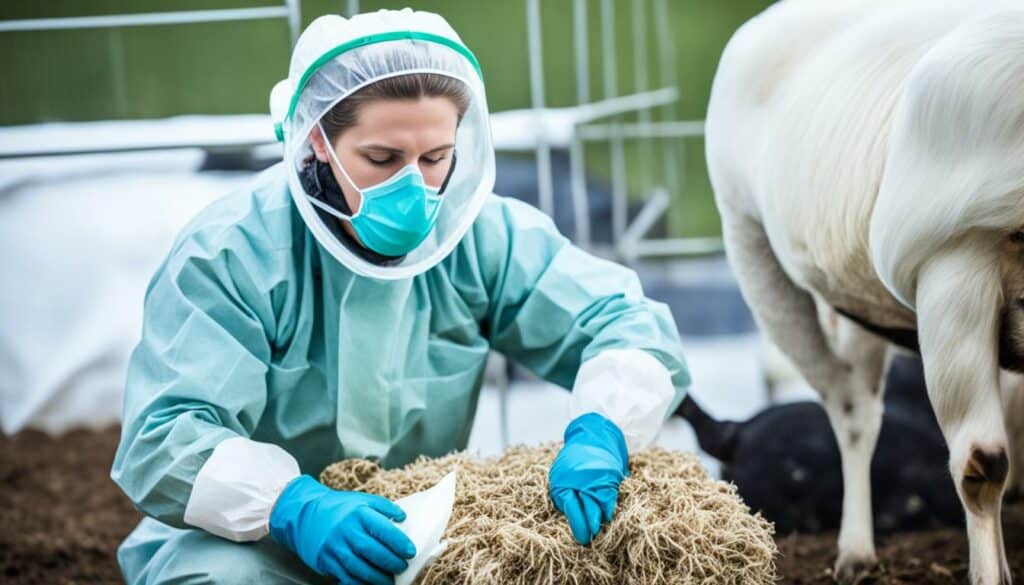
Cleaning well and often is key to avoid spreading germs, especially in shared areas and tools. Even something as innocent as a wooden cutting board can hide dangerous bacteria if not cleaned properly. A strict cleaning schedule for areas where risks are higher can prevent many illnesses.
Some illnesses can spread through water. So, it’s vital to use modern and effective water treatment to keep both animals and people safe. By being careful with water sources, many risks can be reduced.
Watching closely for any signs of sickness among the animals is also essential. Acting swiftly to isolate sick ones can help stop disease outbreaks. These actions are very important in keeping both animals and those who work with them healthy.
Good environmental care on farms helps stop the spread of zoonotic diseases. More than 70% of these diseases come from wildlife. So, it’s vital to keep things clean, get rid of waste properly, and look after animals well. This makes farms safer for everyone and helps them run better.
Keeping animal houses clean is key. It cuts down on harmful germs and viruses. This step is important because farm changes can push wildlife diseases towards people. Doing things like getting rid of plant invaders and planting local trees can make the farm safer. It also helps the environment.
Getting rid of waste the right way is very important. It stops diseases from spreading. Good waste disposal also helps protect against more pests, like certain mosquitoes. These pests can carry diseases too. By managing waste well, farms can be good for the planet and for people.
| Key Factors | Actions | Outcomes |
|---|---|---|
| Cleaning and Disinfecting | Regular sanitation of animal housing | Reduced pathogen transmission |
| Disposal of Waste | Efficient waste management | Lower environmental stressors and vector expansion |
| Ecological Countermeasures | Removal of invasive species, reintroduction of native plants | Enhanced ecosystem resilience and reduced zoonotic spillover |
It’s vital to use antimicrobials correctly on farms. Misusing them can help zoonotic diseases spread. This happens when bacteria get stronger and can even make people and animals sick.
In 2017, the US Food and Drug Administration shared information. They talked about how many antimicrobials were given to animals for food. Also, in Europe, the European Medicines Agency saw how many drugs were sold in 30 places in 2017. This shows that many places around the world rely on these drugs.
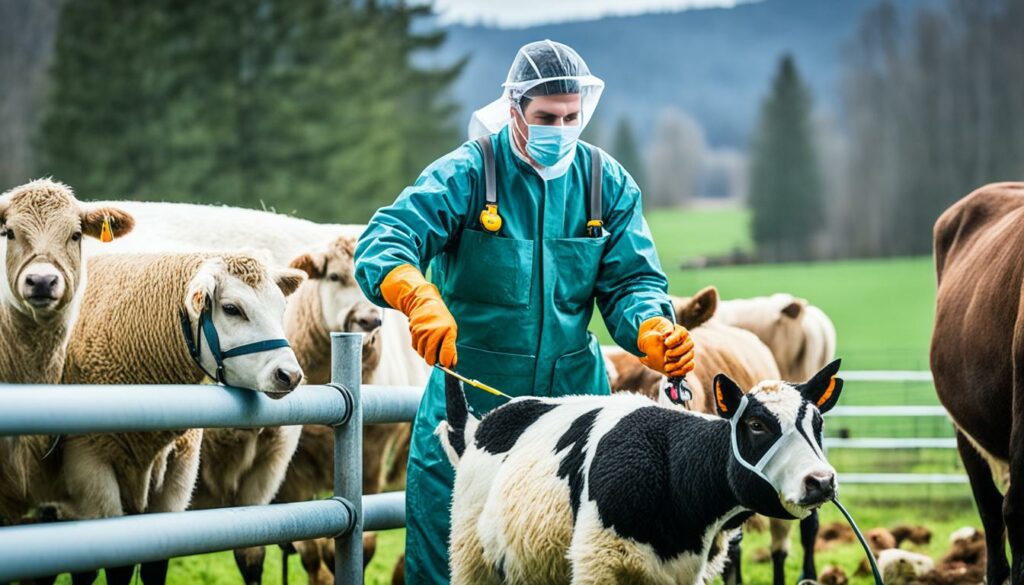
In Vietnam, they checked how many antimicrobials were used by humans and animals. This study showed that the issue isn’t just in one place; it affects the whole world. Other research by Tang et al. in 2017 found that if we use fewer antibiotics on animals, we can slow down how fast bacteria get resistant.
In 2015, Van Boeckel et al. reported on how much we use these drugs on farms. They said we need to work together worldwide to solve this problem. The OIE and FAO also have plans to fight against antimicrobial resistance. These rules show us how to use these drugs wisely.
One big worry is how these drugs can make the environment unsafe. For example, rivers near places that clean water can have strong bacteria from farms. This is a risk for everyone’s health, not just people working in farming.
In Denmark, they found that some antibiotic resistance stayed around for 20 years after they stopped using a certain drug. This shows the effects can last for a long time. In China, there’s a problem with drugs not working called colistin resistance. This tells us everyone must watch and manage carefully how we use these medicines.
| Country | tYear | tFocus of Study |
|---|---|---|
| USA | t2017 | tSummary on sale or distribution of antimicrobials for food-producing animals |
| Europe | t2017 | tSales of veterinary antimicrobial agents across 30 countries |
| Vietnam | tOngoing | tTotal antimicrobial usage in humans and animals |
| Denmark | t2014 | tPersistent vancomycin resistance in pig farms |
| China | t2015 | tEmergence of colistin resistance in animals and humans |
It’s key to follow the right way to use antimicrobials on farms. By doing this, we can help stop bacteria from becoming resistant. This not only keeps animals healthy but also protects us from getting sick.
Farm worker education is key in stopping zoonotic diseases. They learn through structured training to face farm challenges. This training helps in preventing diseases that can spread from animals to humans.
Farm workers join workshops on zoonotic diseases. These sessions show how diseases spread and ways to reduce the risks. The Youth in Agriculture programme has boosted learning in 14 states. This has led to better training tools and more awareness among young farm workers.
Setting clear farm rules helps keep the work area safe. These include how to manage animals and keeping everything clean. The IPC Plan guides in stopping COVID-19’s spread and other diseases too, fitting local laws.
The Emerging Issues Breakfast in Minnesota shows working together matters. Over 60 people from 31 groups met, showing the power of sharing knowledge.
Donation from Washington State Department of Health and Northwest Center for Occupational Health and Safety is vital. It helps make sure farm workers always get better education. This is needed as farm challenges change over time.
It’s vital to always review and assess farm practices to stop zoonotic diseases. These reviews help find weak spots in farm routines. Then, farms can quickly change things to lower zoonotic risks.
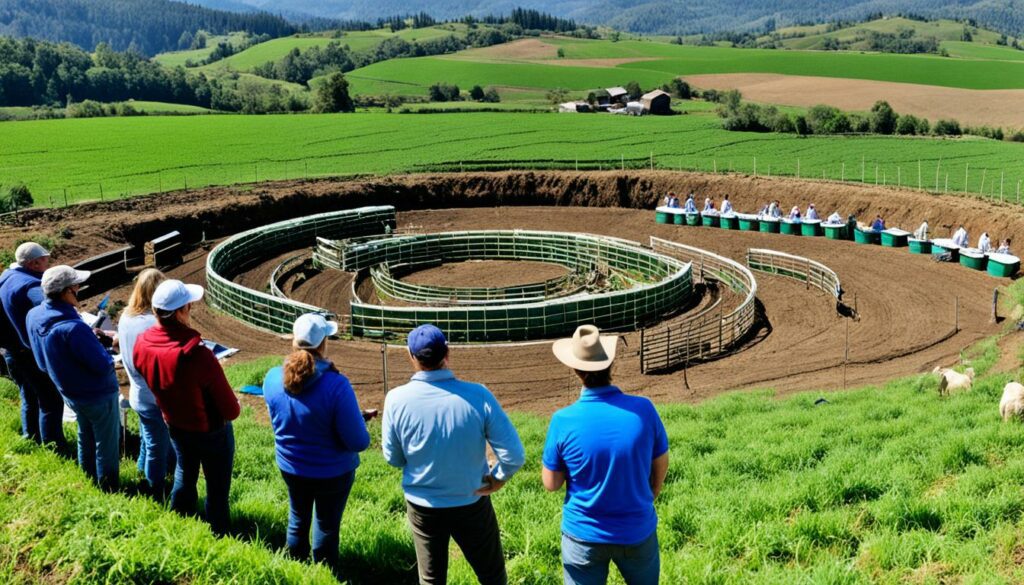
Doing regular farm audits is key for a proactive farm management. Audits check all practices closely to see what can be better. By often looking into these areas, farms can tackle problems before they grow too big. This way, they make sure they’re doing everything they can to keep animals and people healthy.
Keeping zoonotic prevention plans up-to-date is very important. When new info comes out, farms must change their ways to stay safe. This is especially true for diseases like E. coli O157, campylobacteriosis, and cryptosporidiosis. Farms need to always improve their methods to keep everyone safe.
To sum up, regular review of farm practices, along with audits and protocol updates, is critical for fighting zoonotic diseases. This method not just protects livestock but also keeps farm workers and the community safe from zoonoses.
Working together on zoonotic diseases is key for veterinary collaboration and community cooperation in zoonotic prevention. Veterinarians, public health officials, and community members must unite. This teamwork boosts our ability to spot zoonotic dangers fast and react quickly.
Sharing information helps us all act quicker. During the 2003 monkeypox outbreak in the US Midwest, 35 people got sick. Thanks to fast veterinary collaboration, no one died. This example shows how sharing knowledge saves lives.
“Fragmentation of animal disease surveillance systems can hinder communication between veterinarians, public health officials, and physicians.”
Breakdowns in communication hurt community cooperation in zoonotic prevention. Once, 6 people got sick from small turtles. This shows the need for better communication and plans. Working together, we can stop such issues before they start.
Making jobs like working with animals safer is also essential. By working together, we can reduce risks like Campylobacter infection and meningitis. Educating people, such as those who come into contact with rodents, is key. This education can help spot illnesses early.
The main aim is to keep everyone safe from zoonotic diseases. A coordinated effort ensures our response is strong, rapid, and well-coordinated.
| Incident | Details | Outcome |
|---|---|---|
| Monkeypox Outbreak (2003) | 35 laboratory-confirmed cases in the Midwestern USA | 23 vaccinated, zero fatalities |
| Small Pet Turtles | Exposure led to Salmonellosis in 4 children, 1 mother, and an 80-year-old woman | Highlighted need for integrated communication |
| Rodent Exposure | 59% of patients interviewed had Salmonellosis | Emphasised importance of continuous community education |
Tackling zoonotic diseases on farms needs a wide-ranging and detailed plan. It’s key to use strong measures to control these illnesses. This helps keep both the animals and the public safe. Many studies have shown why this is so important.
For example, diseases like brucellosis can harm cow fertility in places like Bangladesh. And rabies is often spread by dogs, especially in countries like China. One big issue is not getting the right treatment for these diseases. The World Health Organization recommends regular vaccination to stop rabies.
Salmonellosis, a bug caught from baby birds and rodents, has caused big problems in the US. There are also concerns over plague, that can come from animals like coyotes. To fight these diseases, farms need to be very careful and clean. Farm and vet workers must work closely together. This way, we can look after the health of both people and animals.
Zoonotic diseases can jump from animals to humans. Some examples are Ebola, SARS, and avian influenza.
These diseases often come from wildlife, farming, or touching infected animals and their environments.
They can cause everything from light sickness to serious, even deadly, health problems in humans.
Farmers can face big financial hits from these diseases. They may lose market access, livestock, and see higher costs.
Diseases can move from animals to humans through direct contact. They can also spread through water and soil.
Keeping animals apart and wearing protective clothes are key steps to cut down on direct contact risks.
Good animal care and feed practices, like room to move and the right diet, keep animals healthy. This lowers the chance of diseases spreading to humans.
Checking on animals’ health regularly and keeping records can help stop disease outbreaks. It allows for quick actions and watching disease trends.
Immunising animals is vital. It stops diseases from spreading to humans, guarding both animal and public health.
New or unwell animals need to be isolated carefully. This prevents them from passing diseases to others.
Farm cleanliness and proper waste disposal are very important. They lower the chance of diseases staying alive and spreading.
Using antibiotics the right way helps fight antimicrobial resistance. This is key for managing zoonotic diseases effectively.
Teaching and training farm workers gives them the know-how to keep zoonotic diseases at bay. It helps them follow safety rules too.
Checking and updating farm protocols keeps prevention plans strong and relevant. It’s a way to stay ahead of these diseases.
When communities and vets work together, they improve watchfulness, react faster to outbreaks, and educate better. This lifts disease control efforts.